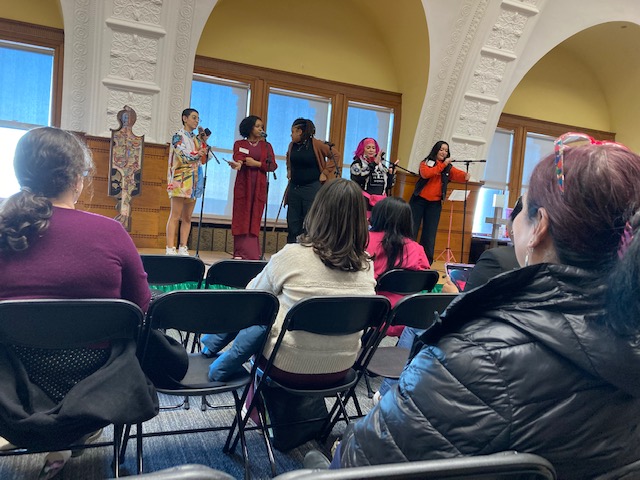
Chicago Women’s History Center held a conference at Roosevelt University in Chicago on March 22, 2025. Scholarships provided opportunities for students to attend as there was a cost for the conference that included a membership to CWHC.
The opening keynote was poet and songwriter Jamila Woods, who presented an interactive introduction to the conference with a PowerPoint of some highlights of important events and women in Chicago’s history.
There were three sessions of panel discussions, presentations, and workshops held in person and by Zoom. I attended in-person. These are my experiences:
Session 1 – “She the People: How the Equal Rights Amendment and Other Parts of the U. S. Constitution Guarantee Equal Rights Under Law to Women”
Lawyer Michelle Thorne of ERA Illinois and League of Women Voters Chicago President Jane Ruby presented recent events they attended and background of the history of the ERA with a Q&A and next steps of action for the ERA to be printed as the 28th Amendment to the U.S. Constitution.
Jane’s part focused on her participation in D.C. and at the U.N. on the rights of women. Michelle’s focused on history of women’s rights in the U.S., which included women going to jail for attempting to vote (included Susan B. Anthony prior to the passage of the 19th Amendment allowing women to legally vote).
Michelle quoted President Biden’s exit statement that the ERA has passed all the requirements to be recognized as the 28th Amendment as declared by the American Bar Association. However, it is not a power the president has. Congress has the power to declare it official, not the archivist or the president.
Both women promoted t-shirts with ERA messages they were wearing and buttons were distributed.
Obstacles
- States rescinding ratification: Two states rescinded ratification of the 14th Amendment and Congress decided it didn’t matter when declaring it was part of the Constitution.
- Time limit: Unlike other amendments that had such requirements the time limit is not in the text of the amendment Congress voted on.
Action: Continue contacting members of Congress to pressure them to publish the 28th Amendment and have the ERA as law.
Session 2 – “Socialist Feminism: Our Strategy for the Women’s Movement”
I attended a presentation during the second session held by my friend now living in D. C., Christine Riddiough. Christine’s opening statement was on combatting the backlash against the last fifty years of progress by the rise of Donald Trump and the organized conservative movements.
Through her PowerPoint presentation and telling of her personal journey of activism, Christine’s focus was on Chicago Women’s Liberation Union, of which she was a member. CWLU was founded in 1969 and played an active role in the women’s liberation movement in Chicago and beyond during much of the 1970’s. CWLU focused both on action and discussions of strategy and theory so that actions taken were thought out.
Through the PowerPoint slides, Christine showed the different committees of CWLU, from the Graphic Arts Collective (which made posters) to the JANE Collective (founded by Heather Booth and provided abortion services pre Roe v Wade) and leadership training through Midwest Academy (also co-founded by Heather Booth).
Action: The Q&A portion discussed today’s movement to get past personal agendas to combat the attacks from the current administration on civil rights, and on laws that gave us more access to equity (disability accommodations, LGBTQIA+ rights, studies in minority culture, and history, etc).
Session 3 – Art & Activism Panel
Each panelist presented their segment with a PowerPoint presentation to showcase their points.
Ana Shin-Olp: “A Free Woman Equals a Free Body: Bloomerism Movement (1850’s – 1940’s)”
Ana examined the idea of fashion and dress practice coexisting in the spaces of reform and political movements and how criticism of how someone looked, as today’s TikTok, Instagram, etc. bullying serves as backlash on ideas and politics.
Ella Grace: “The Past, Present, and Future Fight for Gender Equity in Jazz”
Ella is a professional jazz musician who finds herself as the only woman in the room. She spoke about the history of jazz being founded in African American culture and its embrace of improvisation and individualism, and how the genre has marginalized women at all areas of the industry. She moves to examine strategies combating gender inequality in jazz foremost, but also other musical genres and other industries.
Marin Burke: “This Woman’s Work: Quilting for the American Red Cross (1917 – 1918)”
Marin focuses on the home front volunteers for the American Red Cross mainly from the Midwest. Thanks to the quilting efforts in churches, Red Cross branches, women’s clubs, and individuals, thousands of dollars were raised.
Conference Conclusion
Ending the conference were performances led by Hip Hop artist Pinqy Ring. Performing with Pinqy were four of her mentees from the John Walt Foundation: Ms. Mamas, writer and journalist, whose debut book “Crockpot Poetry” is about to be published; Adilene, a poet and producer working at an independent record label; Anita, a self-taught flutist of 13 years; and YesI Oasis, a creative consultant and multidisciplinary artist, blending poetry, photography, graphic design and mixed media.
The conference was conceived by CWHC, partnered with Black Metropolis Research Consortium, Evanston History Center, and Women and Leadership Archives at Loyola University Chicago. Additional sponsors were Women’s International League for Peace & Freedom U. S., Skyline Village Chicago, and Chicago Hyde Park Village supporting scholarship program.
